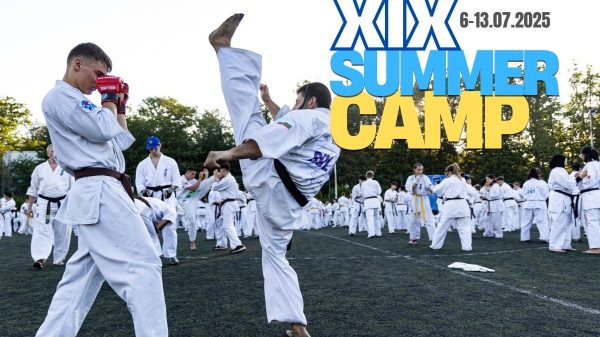Are flexibility exercises a real pain for you? Until I discovered something called PNF Stretching, they used to be for me, too!
It means, “Proprioceptive Neuromuscular Facilitation.” Fancy words that, in essence, mean you make dramatic gains in how limber you are when you combine relaxed, passive stretches with isometrics.

Yes, dramatic gains. Believe me–I know from experience!
My martial arts students think I’m pretty flexible, but the truth is, I was never a naturally flexible athlete. If anyone has ever struggled with flexibility, it’s me! In fact, when I started practicing Martial Arts in my early twenties I was so out-of-shape I didn’t know my hamstrings from a ham sandwich!
And let me tell you, I had a tough time learning how to get loose enough just to lob a regular round kick to my own head height.
Maybe this has been you’re experiencing, too: I would arrive an hour before my scheduled class time, sit on the floor off to one side of the room, doing stretch after stretch after stretch until I could finally do the high kicking my belt rank required.
And the next time I came back to class, I had to do it all over again…
And again…and again…
Why Passive Static Stretching Doesn’t Work
And a curious thing after all that stretching, instead of feeling ready to get out there and do a good workout, I always felt a bit sleepy.
The reason is obvious to me now. What I didn’t know was that all that passive exercise stretching was helping me to slow down, not warm up!
Why? Because in passive exercise stretching, lengthening of the muscles is accomplished by relaxing them, with a little bit of help from applying your body’s weight to the point where you feel the “burn.”
All that relaxation along with deep breathing during the stretch is great for winding down after a workout-or for that matter, as a cure for insomnia.
Believe me, I know how frustrating it can be to try to achieve Martial Arts flexibility that carries over into your “off hours.” And when it comes to Personal Safety, that’s where you really need it the most.
There’s Got To Be A Better Way
It was also frustrating to see other, more flexible people toss their kicks around like their legs and hips were made of rubber. I started thinking, There’s got to be a better way to get flexible!
And there is. After researching many articles and books, and videos, I discovered that Stretching isn’t just Stretching. In fact, there are several kinds of flexibility techniques:
-
- Passive
- Active
- Static
- Dynamic
- Ballistic
- Resistance PNF
Passive stretching is okay after a workout but doesn’t do much to prepare you for high kicks. In fact, what I eventually learned was that most of the improvements to my kicking range came through sparring and heavy bag work.
That’s right-although you can help prevent injuries and cramps by passive stretching before a workout, it does very little to improve your high kicking ability.
So why did sparring and bag workouts work instead?
Because when you’re kicking-that is elongating the muscles involved-then suddenly contracting them with isometric resistance (by your opponent’s block, or your contact with the bag) the resistance during the stretch is what really causes the muscle to elongate!
PNF: The Key To Incredible Kicking Range
Maybe like you, I searched books, videos, and web sites until I finally learned this lesson about isometric resistance in flexibility. And if you haven’t done a ton of research yet, let me save you some time!
The answer I found was in Proprioceptive Neuromuscular Facilitation. This type of flexibility exercise is done by alternating passive with isometric stretching.
How PNF Works
Isometric flexibility is when you passively extend the muscle to the point where you start to feel the “burn,” and then contract the muscle. Introducing tension to a passively lengthened muscle sort of “tricks” the muscle into thinking it can maintain this longer length. After the isometric, the muscle will relax further into the passive stretch. Regular, continued practice of PNF stretching produces the fastest and most dynamic results for the flexibility you need to practice Martial Arts.
Try These Two Easy Stretching Exercises
These two, easy PNF exercises will get you started on a path to amazing Martial Arts flexibility.
Side Splits
Start in a traditional horse stance. Keep your toes pointing straight ahead. Tilt your pelvis forward and keep your back upright. Try to keep your thighs parallel to the ground as much as possible during this stretch!
Work your way down until you start to feel pain, and no further. Now tense your leg muscles for 3 to 5 seconds, then relax. If you are able, go down a little bit more. Tense and relax the muscles again. Do this four times. On the fourth time, try to tense and hold for 30 seconds.
Repeat this whole sequence 3 to 5 times. You should not do this before you are warmed up. The best time for the Isometric Side Splits is during or near the end of your regular workout, then do passive stretching at the very end.
Front Splits
As great as it is to be able to do the Side Splits, Front Splits is probably even better for Martial Arts. If you consider the position of your body when doing a round or front kick to the head, the Front Splits more closely resembles that position than Side Splits.
Start by extending one leg straight out in front of you. Position your rear leg so that it lines up with the front.
It helps if you support your weight with a chair off to one side. Be very careful how far you stretch the hamstring of the front leg. The ability to perform these splits isn’t only in having a limber hamstring, but also the flexibility of the front thigh muscles (quadriceps).
For the isometric part of this exercise, tense both the hamstring of the front leg and the thigh muscles of the rear leg at the same time, as if you’re trying to pinch the floor with your front heel and back knee. Hold for 3 to 5 seconds.
Relax…go a little further if you can. Tense and hold again. On the fourth time, try to tense and hold for 30 seconds.
As with the Side Split exercise, repeat this sequence 3 to 5 times.
Developing great flexibility doesn’t have to be a pain–in fact, when you learn how it’s really a lot of fun and very rewarding! These exercises will get you started on a journey toward amazing flexibility for Martial Arts practice. In no time, you will be able to kick targets at your own head level with remarkable ease.
Source: fittalk.com.au




































